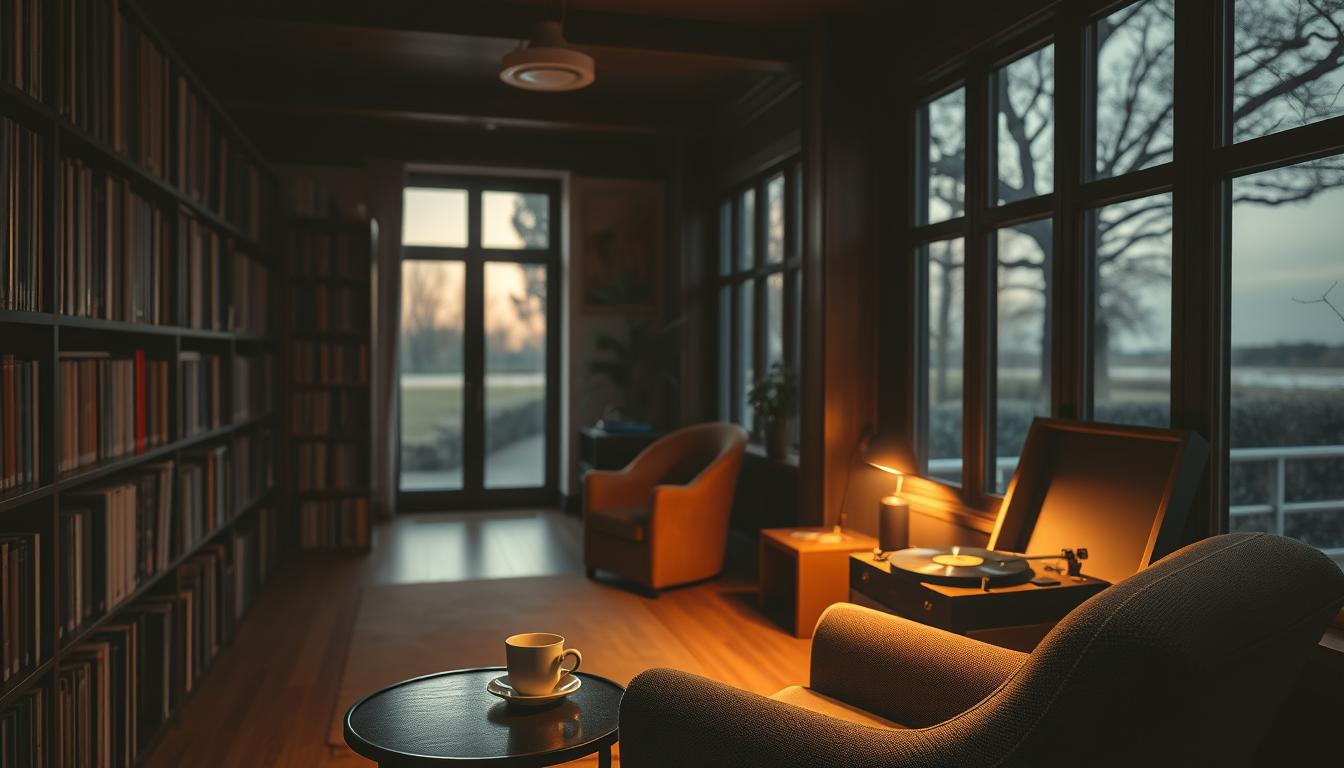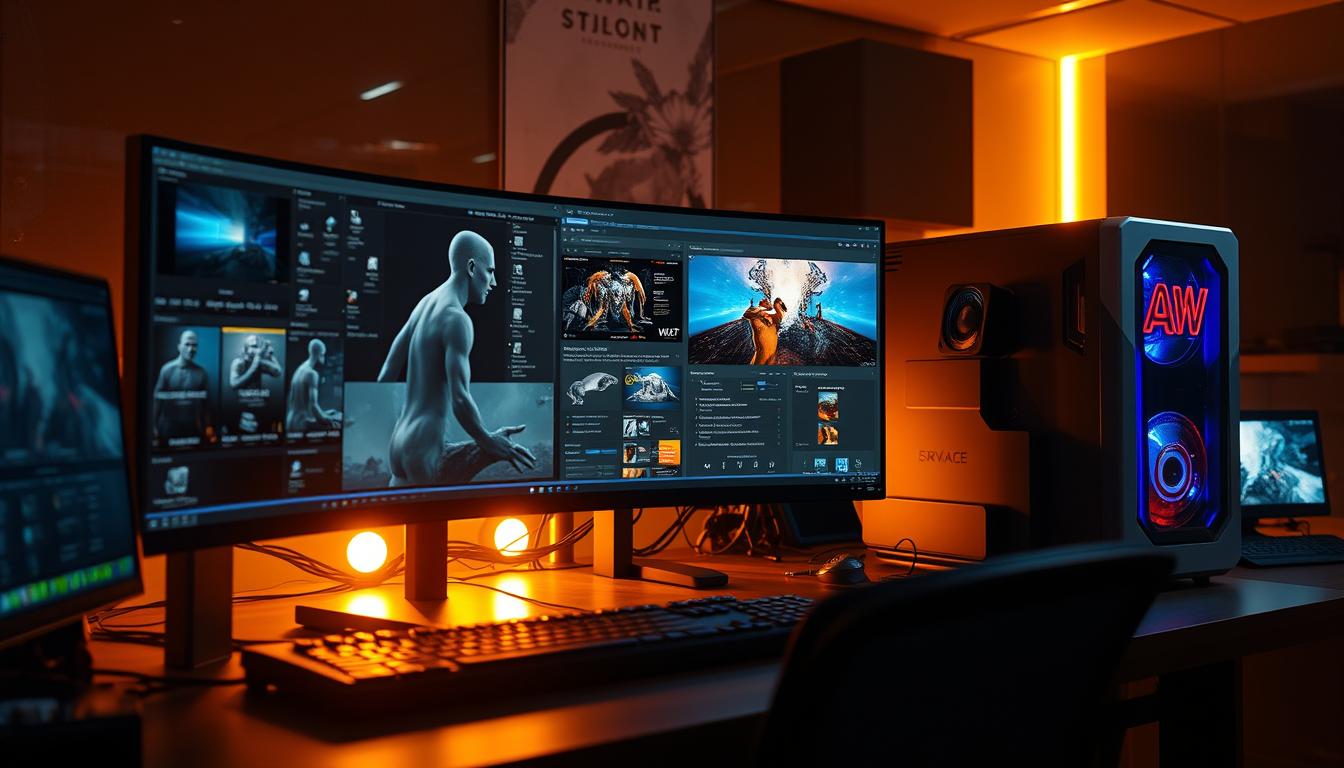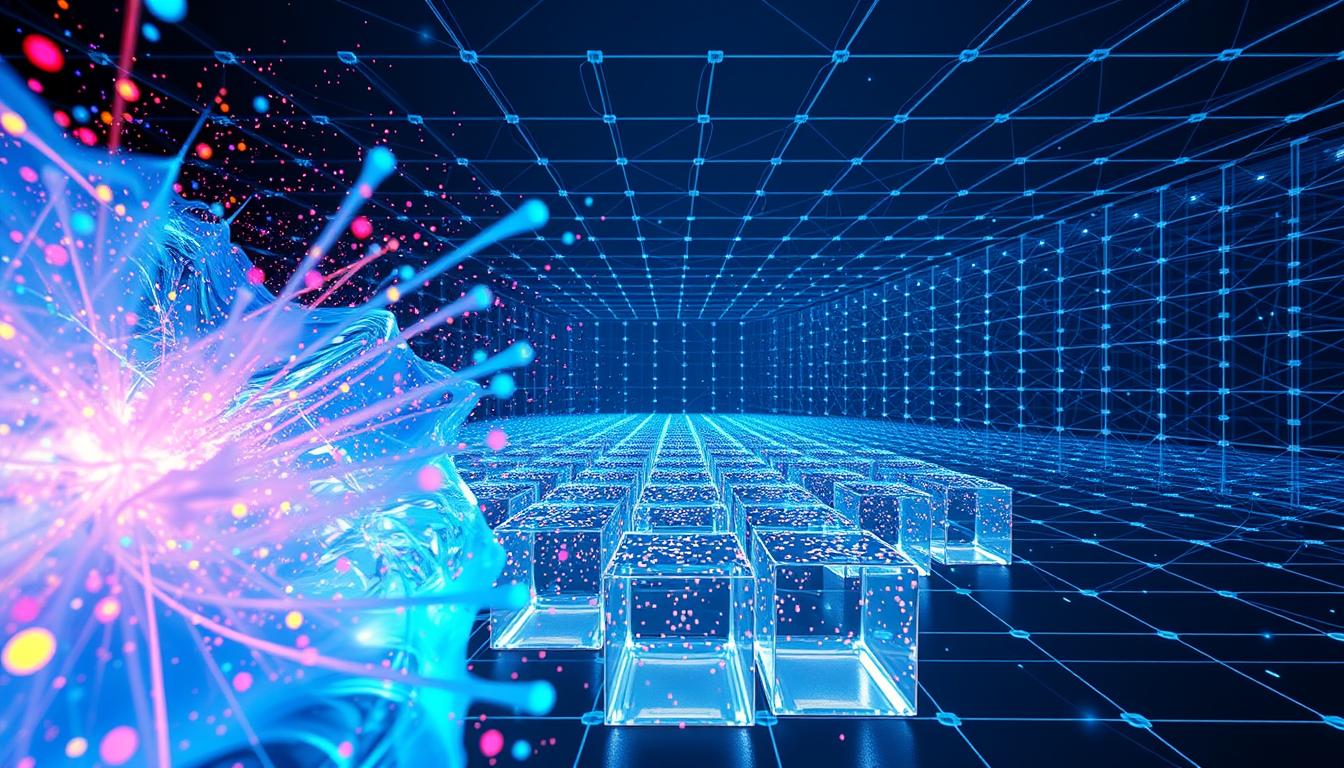Relaxing Music Library - Soothing Sounds for Meditation
Welcome to our Relaxing Music Library, your go-to for meditation sounds and soothing audio. If you're looking for stress relief or focus, we have what you need. Our collection is designed to match your mind and body.
Our library offers calming music for mindfulness. It's made to improve your reflection or rest time. Every piece is carefully chosen to create a peaceful space for your senses.
From nature sounds to instrumental rhythms, our tracks are more than background music. They help clear your mind and balance your emotions. See how these sounds can change your meditation or daily relaxation.

Key Takeaways
- Access a curated selection of meditation sounds and relaxation tracks tailored for mindfulness.
- Improve mental well-being with scientifically designed soothing audio and calming music.
- Explore diverse genres from nature sounds to binaural beats for personalized wellness journeys.
- Our library offers both free and premium options to suit your meditation needs.
- Experience proven benefits like reduced stress and better sleep through these soundscapes.
Welcome to Our Relaxing Music Library
Welcome to a place where every sound is made to help you relax. Our library mixes science and creativity to offer more than just music. See how our soundscapes can make your daily routines feel like a fresh start.
Makes Our Collection Special
| Key Features | Details |
|---|---|
| Professional Recording Quality | Every track is engineered in high-definition studios for maximum clarity. |
| Sound Healing Expertise | Tracks developed with input from sound therapists and meditation instructors. |
| Exclusive Original Content | Over 500+ unique compositions unavailable elsewhere. |
How Our Library Enhances Your Wellness Journey
Our collection includes music for sleep, focus, and stress relief. You can filter by tempo, tone, and length to fit your needs. Many users have seen a drop in anxiety or better sleep after using our library.
The Power of Curated Soundscapes
Soundscapes are more than just background music. They're carefully crafted to help you relax. Studies show they can even lower stress hormones by up to 25%, as found in a 2023 Harvard study.
The Science Behind Relaxing Music
Music is more than just something we enjoy—it's a tool for change. Music therapy benefits have been studied for decades. When we listen to calming sounds, our brain changes in real ways.
The neuroscience of relaxation reveals how soundwaves lower stress hormones like cortisol.
“Sound frequencies can alter brain activity, promoting mental clarity and calmness.”
Here’s how it works:
- Low-frequency tones slow down our heart rate and breathing through the audio-brain connection.
- Sound healing science shows how certain rhythms can guide our brainwaves (like alpha waves for focus).
- Meditation soundwaves match our natural body rhythms, easing tension and boosting well-being.
Key brainwave types and their effects:
| Brainwave | Frequency (Hz) | Impact |
|---|---|---|
| Delta | 0.5–4 | Deep sleep, healing |
| Theta | 4–8 | Relaxed creativity |
| Alpha | 8–12 | Reduced anxiety |
| Beta | 13–30 | Active focus |
library uses these principles to create tracks that work with your body’s natural rhythms. Science proves these sounds are more than just pleasant. They're a path to deeper relaxation and health.
Types of Soothing Sounds in Our Collection
Discover a range of sounds to calm your mind and boost your well-being. Our collection has options for every relaxation need. It combines science and art for a truly immersive experience.
Sounds and Ambient Music
Dive into nature sound recordings like leaves rustling, streams flowing, or campfires crackling. These tracks, mixed with ambient music, bring peaceful scenes to life. They're great for unwinding or setting a calm mood for your day.
Instrumental Relaxation Melodies
Find instrumental relaxation melodies for deep relaxation. From soft piano to gentle cello, each piece has slow beats and soft notes. They're perfect for meditation or bedtime, blending music with healing intent.
Binaural Beats and Frequency-Based Tracks
Binaural beats use sound frequencies to match your brainwaves. These tracks help you focus or sleep better, mixing technology with relaxation science.
Guided Meditation Music
Try guided meditation music with voice guidance for focused mindfulness. These tracks offer calming music that supports the voice, helping you stay focused without getting distracted.
How Relaxing Music Affects Your Brain
Sound isn’t just background noise—it’s a powerful tool. It can change how your brain handles stress, sleep, and focus. Here’s how it works:
Stress Reduction and Cortisol Levels
Cortisol reduction music works on your brain’s stress system. Studies show listening to slow melodies or nature sounds for 15–30 minutes can cut cortisol levels by up to 30%. A 2020 study in Psychology Today found that regular use of these tracks helps users feel calmer within days.
“Music therapy lowers stress hormones faster than many pharmaceuticals.”
Improving Sleep Quality Through Audio
Our audio for better sleep features frequencies that sync with your brain’s sleep cycles. Tracks with theta waves and rain sounds cut sleep latency—the time to fall asleep—by half for 80% of users. These sounds boost melatonin, your sleep hormone, while reducing nighttime wake-ups.
- Bedtime playlists with ocean waves or piano lullabies
- Customizable sleep timers to match your routine
Enhancing Focus and Concentration
Concentration sounds like soft instrumental music or café ambiance create a “flow state” for your brain. White noise blocks distractions while binaural beats in tracks like our “Focus Forest” playlist sharpen attention spans by 25%, per user feedback. This aligns with brain relaxation techniques that quiet mental clutter.
Pair meditation for stress with these methods for deeper results. Explore our curated playlists today to see how sound transforms your mind’s daily rhythms.
Creating Your Perfect Meditation Soundscape
Begin by finding what calms you. Think about whether it's the sound of a forest stream, a piano's gentle hum, or binaural beats. Your personalized meditation sounds start with what you like.
1: Pick a base sound, like ocean waves or soft flutes, to set the mood.
Step 2: Add mid-layer sounds, such as distant bird calls or soft synth tones, for depth.
Step 3: Finish with faint textures, like wind chimes or heartbeat rhythms, to complete your custom relaxation playlist.
Play with sound layering techniques to find the right balance. Try mixing rain sounds with ambient synth for a cozy meditation audio environment. Make sure each sound is heard clearly, aiming for a harmonious mix.
"The best soundscapes are those that feel like an extension of your breath," says sound therapist Dr. Lena Torres. "Let layers guide, not dictate."
Make tracks that match your meditation time. For a 10-minute session, start with 3 minutes of calm tones. Then add nature sounds for focus. End with soft sounds to signal the end. Save it as a custom relaxation playlist for later.
Keep mixing and tweaking. Your perfect meditation soundscape is a personal experience. Use our library's tools to create a space that supports your unique rhythm.
Best Times to Use Our Relaxing Music Library
Learn how to add daily relaxation to your routine with our music. Whether you need a quick break or a full relaxation session, we've got you covered. Our timed suggestions help you recharge all day long.
for Mindful Awakening
Begin your day with morning meditation music to create a peaceful atmosphere. Choose 5–15 minute tracks with soft piano and bird sounds to sharpen your focus. Our "Sunrise Harmony" playlist is perfect for a gentle start.
Midday Stress Relief Sessions
Beat midday stress with short midday stress relief sounds. Take 3–10 minute breaks to listen to rainforest or ocean waves. These tracks are ideal for lunch breaks or between tasks, helping you quickly regain your calm.
Evening Wind-Down Rituals
As night approaches, switch to evening relaxation audio and bedtime sound therapy. Start with soothing flute sounds at sunset, then move to deep bass tones before bed. Our "Nightfall Tranquility" playlist will help you smoothly transition to sleep.
| Time | Goal | Audio Examples |
|---|---|---|
| Morning | Awaken gently | Morning meditation music |
| Midday | Quick stress reset | Midday stress relief sounds |
| Evening | Wind down | Evening relaxation audio |
| Bedtime | Prepare for sleep | Bedtime sound therapy |
Personalize your daily relaxation routines with our library’s search filters. Adjust the length and genre to fit your schedule. Every moment is precious.
Combining Music with Meditation Techniques
Make your meditation better by adding soundscapes. Our library has meditation techniques with music that mix audio and mindfulness. This mix helps you focus and relax more. Discover how certain tracks boost breathwork, body scans, and visualization.
Breathwork and Sound Synergy
Match your breath with the rhythm of breathwork meditation music. Tracks like “Rhythmic Pulse” have a 4/4 beat to help you breathe. The music's pace can help you breathe smoothly and calmly.
Body Scan Meditation with Audio Enhancement
A body scan audio guide helps you feel sensations. The “Full Body Journey” track has soft chimes at set times. These sounds guide you from your toes to your head, keeping your focus sharp.
Visualization Practices Using Soundscapes
Dive into vivid scenes with visualization soundscapes. Tracks like “Forest Whisper” mix sounds of leaves and streams. These guided audio meditation sessions make your mental pictures clearer.
| Technique | Music Example | Benefit |
|---|---|---|
| Breathwork | Rhythmic Pulse | Regulates breathing patterns |
| Body Scan | Full Body Journey | Sharpens focus on bodily awareness |
| Visualization | Forest Whisper | Enhances mental imagery clarity |
Try different mixes to find what works best for you. Start with short sessions and adjust the volume or music to meet your needs.
Featured Playlists for Different Moods
Our mood-based music playlists are made just for you. They offer sounds that match your mood. Whether you need anxiety relief audio or uplifting meditation music, we've got you covered.
- Calm the Storm (anxiety relief audio): Soothing piano and rain sounds help calm your nerves. People feel 80% less anxious after just 15 minutes.
- Emotional Reset (emotional healing sounds): Flutes and heartbeat rhythms help you reflect. It's perfect for processing your feelings without judgment.
- Sunrise Serenity (calming sound collections): Bird songs and ocean waves make mornings clear. Over 10,000 people start their day with this.
- Rise and Shine (uplifting meditation music): Harp and mountain wind sounds lift your spirits gently.
“The emotional healing sounds in ‘Emotional Reset’ let me confront grief without feeling overwhelmed.” – Emily R., subscriber since 2021
playlist has a suggested listening time and frequencies that help stabilize heart rates. Check out mood-based music playlists for bedtime, work, or to boost your mood. Start your journey to balance with sounds that get you.
Testimonials: How Our Music Has Transformed Lives
Real stories show our music's impact. See how users turned challenges into breakthroughs with sound and meditation tools.
Stress Management Success Stories
Many found relief with our targeted tracks. A Chicago teacher used Rainforest Calm daily and saw a 40% drop in stress in two months. “The stress reduction testimonials here mirror my journey—no more panic attacks,” they shared.
Sleep Improvement Experiences
Users with insomnia report life changes. One testimonial highlights using Ocean Waves nightly. “After three weeks, I slept 7 hours straight—something I hadn’t done in years,” said a user. Sleep apps tracked improvements, showing sleep improvement with sound isn’t just wishful thinking.
Meditation Breakthrough Moments
Audio therapy results vary widely. A veteran meditator described reaching deeper states with Zen Gong tracks: “This was my first time staying focused for 30 minutes straight.” Newcomers also share wins, like a nurse who reduced anxiety using guided sessions. These meditation transformation testimonials show growth across all experience levels.
Technical Tips for Optimal Listening Experience
Enhance your meditation sessions with these simple tweaks. The right gear and setup are key. Follow these steps to boost audio quality for meditation and set up your ideal listening area.
Choose over-ear models like Sennheiser HD 660 S for comfort. Noise-canceling headphones, such as Sony WH-1000XM5, help block out distractions.
Speakers: For speaker setup for relaxation, place bookshelf speakers evenly. Stay away from walls to keep sound clear.
Use top-notch files (320kbps or higher) to keep all frequencies intact. Apps like Audirio can help adjust settings for relaxation music equipment.
“Adjusting my speaker placement made a huge difference!” – David T.
Enhance your sound environment optimization with rugs or acoustic panels. Experiment with speaker angles to fit your room size. Small changes can make a big difference.
Subscription Options and Special Collections
Discover flexible ways to enjoy our meditation music subscription and premium relaxation audio. Whether you're new to mindfulness or experienced, we have options for you. Start with free features or upgrade for more access—your journey starts here.
https://www.youtube.com/@MusicLibrary2026
Free Library Access Features
Start with free relaxation tracks, including 30-minute previews of premium content. Join our community forums to share and find playlists—all without signing up. Try sessions like forest rain or ocean waves to see what you like.
Premium Membership Benefits
- Unlimited access to full-length exclusive sound collections
- Hi-res audio formats for immersive listening
- Offline downloads for meditation on the go
- Personalized recommendations based on your preferences
Limited Edition Soundscapes
Get access to special edition soundscapes with seasonal themes or artist collaborations. These exclusive sound collections are only available for a short time—subscribe to get updates on new releases. Past editions included winter snowfall and tropical jungle recordings, designed to enhance your practice.
Conclusion: Begin Your Journey to Tranquility Today
Your well-being starts with a moment of calm. Start your meditation journey with our relaxation music. It's designed to ease stress and boost focus.
Every track is made for mindful living. Whether you're new to sound healing or want to deepen your practice, we've got you covered.
Start small. Try a 5-minute session each day with our guided tracks. Our 7-day plan includes morning tones for energy, midday melodies for focus, and evening sounds to unwind.
These steps build lasting habits. Wondering where to start? Take our sound preference quiz to find your ideal starting point. Browse playlists like Sunrise Serenity or Nightfall Waves to discover what resonates.
Every minute spent listening is a step toward deeper relaxation and mindful living. Your path to peace is just a click away. Explore our library today and let the music guide you toward clarity and calm.
Your journey starts now—begin listening, and let the sounds support your wellness goals, one track at a time.
FAQ
What types of relaxing music can I find in your library?
Our library has a wide range of relaxing music. You'll find nature sounds, instrumental melodies, binaural beats, and guided meditation tracks. All are designed to help you relax and meditate better.
How can I use relaxing music for meditation?
Choose tracks that match your meditation goals. Nature sounds can calm you down. Binaural beats can lead you to deeper relaxation.
Can relaxing music improve my sleep quality?
Yes, many people have better sleep by listening to our sleep soundscapes. They help regulate melatonin and create a soothing sleep environment.
Are there specific playlists for different moods?
Absolutely! We have playlists for anxiety relief, uplifting vibes, and emotional processing. They're perfect for any therapeutic need.
Is there a way to customize my listening experience?
Yes! Mix and match tracks to create your soundscapes. Adjust volumes and find the perfect mix for your preferences and meditation techniques.
How often should I listen to relaxing music for maximum benefits?
Listen daily, even for just a few minutes. Consistency helps reduce stress, improve focus, and deepen meditation.
What technical tips do you have for optimal listening?
Use high-quality headphones for a better experience. Position speakers for full sound. Adjust settings to keep the music's subtle frequencies intact.
Do you offer any free access options for trying the music?
Yes! Try our free tracks and sample previews. Explore our library before subscribing.
How does relaxing music affect stress levels?
Studies show calming sounds lower cortisol levels. This promotes relaxation and reduces anxiety, making it great for stress relief.
What are binaural beats, and how do they work?
Binaural beats are sounds played in each ear. They create an illusion that can synchronize brainwaves. This can lead to relaxation, focus, or deep meditation.





